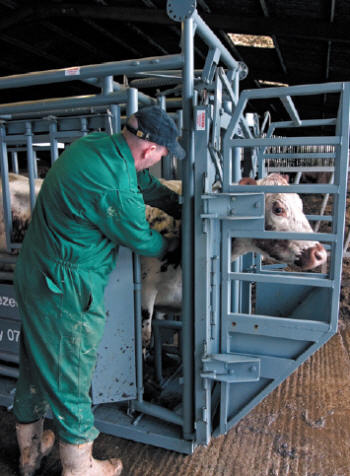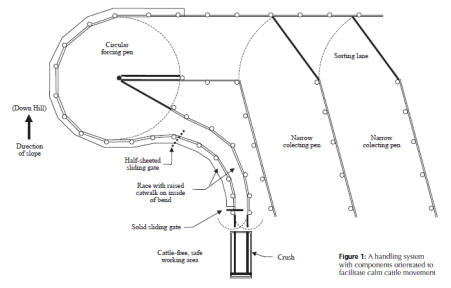



Cattle Movement Systems
How can a new or upgraded cattle handling system improve safety and efficiency? Charlotte Johnston, TheCattleSite junior editor looks at the risks when handling cattle, how a good handling system can minimise these risks and what to look for when redesigning or improving your current facilities.Every year there are a number of casualties to both men and cattle from working with faulty handling systems. These risks can be reduced through planning and designing a good handling system. Further more, an efficient handling system could cut down money spent on labour as well as saving time handling the cattle.
Risk factors when handling beef cattle
Professor Neel, Professor of Animal Science and Extension Beef Cattle Specialist at The University of Tennessee, warns that producers should be aware of the risk of injury when working with cattle, particularly if the facilities are not in a good state of repair.

In the field: cows with young calves or bulls can be a risk to the handler when carrying out tasks such as checking, herding and ear tagging young calves. Where possible more than one person should be present.
When public rights of way cross the land, there is danger to the public, especially when walking dogs. After recent deaths and attacks on the public in the UK, farmers have been encouraged to put up signs giving a clear reminder to walkers using public footpaths: 'Your dog can scare or harm farm animals - Keep it on a lead around livestock, but let go if chased by cattle.'
In the home pen: Threats include being kicked or knocked to the ground and subsequently trampled or being crushed. Use a handling system that allows maintenance to be performed from a passageway. Where possible Simon Turner, Alistair Lawrence and Basil Lowman, Scottish Agricultural College (SAC) recommend:
- minimising the need to enter the pen to perform maintenance tasks;
- having facilities which allow separation from the animal and handler;
- having protection from crushing;
- ensuring there are easy escape points.
Purposes/ Benefits of a Good Handling System
A good handling system will increase performance, reduce labour expenses, improve safety and improve animal welfare says Grant Ellington, North Carolina extension associate.
Increase performance
Handling cattle correctly will reduce stress allowing them to perform better. Having adequate handling equipment (non-slip floors, no sharp corners) in place will also reduce injuries such as broken bones, bruises and cuts - all of which may reduce feed intake. Mr Ellington estimates that bruising costs the US cattle industry $22 million each year.
Edward Penty, who supplies Squeeze-Crush cattle handling equipment, says that the squeeze crush enables the animal to be held fast in the crush, which reduces bruising and stress but also protects the farmer.
A lack of proper facilities will make it difficult to effectively manage the herd. Adequate facilities can have huge benefits for a herd health plan. For example, if facilities are in place to restrain cattle correctly, dehorning and castrating can be carried out easily and efficiently. Vaccinations can also be administered allowing prevention of disease.
Reduce labour expenses
For smaller, medium sized herds having a well-designed handling facility may allow producers to work alone, reducing labour requirements. An efficient handling system will also allow easier movement and flow of animals, so less time will be spent chasing animals into pens or preventing them turning - reducing handlers stress! Mr Penty, says that Squeeze-Crush will save the producer time, for example when fostering on calves, the crush prevents the cow from kicking (which many standard crushes wouldn't allow) and a small access gate allows the calf to easily access the teat, the farmer can then leave the cow and calf in confidence that both are safe and do other duties.
Improved safety
As already identified, there are a number of dangers to those working with cattle. A good handling system will protect the handler from crushing and falling by ensuring that cattle move calmly. It will also allow the handler safe access to work on the animal. Mr Penty, stresses that although Squeeze-Crush may be slightly more expensive than other handling facilities, many of his sales are too people who have been previously injured when working with cattle or who have staff insurance or health and safety issues to consider.
What to consider when designing a handling system?
* "If you have to shout loudly and beat the animals with sticks, the chances are that your handling system is set up incorrectly or is inadequate." |
|
Edward Penty, Squeeze-Crush
|
Corners
Dr Turner says that cattle often perceive 90° corners as dead-ends. Having these sharp corners in the handling system will stop the movement of cattle flow. Further more corners and sharp objects cause injuries mentioned above such as bruising.
Visual disturbances
Shadows or changes of colours on the ground will restrict the ability to move cattle. Where possible, Mr Ellington suggests, reducing the number of shadows. Sheeting along the race, will not only eliminate intermittent shadows, but will also stop visually disturbances of other cattle, people moving about.
Mr Penty suggests that sky lights often cause more problems than they solve and if possible fully sheeted sheds with 100 per cent artificial lighting is ideal. This will provide consistent light and keep cattle movement flowing.
Flooring
Poor flooring with little grip is a risk to both the handler and cattle as it may cause either to slip and injure themselves. Surfaces that are worn and smooth should be regrooved. Cattle are unlikely to move towards areas of water therefore floors should also have some form of drainage, Dr Turner recommends an angle of 4°.
Wide passages
Wide passages will allow animals to turn around, creating more work for the handler.
Gates
Poor placement of gates will create difficulties when moving cattle and restrict cattle flow, place gates to avoid looking like dead ends, perhaps at an angle. Cattle may also close gates as they are moving through. Giving gates the ability to tie back to a full 180°, prevents cattle closing the gate or injuring themselves on it. Also ensure that there are no sharp protruding parts of gates that may injure the cattle or handler.
Noises
Loud noises such as chains banging together will cause cattle to be more stressed and excitable.
Collecting and dispersal pens
Narrower pens will allow easier movement of cattle and can often be managed by one handler, as there is less chance of cattle escaping past. Setting the collecting pen at a gentle angle to the exit lane will allow easier movement of cattle, eliminating corners. Putting 0.36m wide gaps into the wall will provide escape passages to protect the handler from crushing. It may also be worth considering safety posts or foot steps at the base of walls to facilitate the escape of the handler. Figure 1 is a design by the SAC, Dr Turner and suggests using two narrow collecting pens.

Forcing pen
Cattle move slowly through straight-edged forcing pens, however if one is in place one side should angle towards the race entrance at 30 degrees. A sharp angle between the exit from the forcing pen and the entrance to the race should be avoided or the efficiency of movement will be reduced.
Much of the same applies as above, a well designed forcing pen will again protect the handler from crushing and encourage movement towards the rate entrance and prevent the animals from turning. A shallow angle will be more effective than a sharp corner at turning the cattle into the race. Dr Turner recommends fitting gates with self-locking back-stops to prevent accidental opening will save handlers time. Figure 1 above shows a circular design which are often easier to work and prevent animals from collecting in a corner. Here high solid sides will prevent visual disturbances that may startle or frighten animals and keep them calm.
The combination of a curved race and circular forcing pen, both with sheeted sides has been shown to work in Australia to reduce the time needed to move cattle by up to 50 per cent.
Race
The race should encourage cattle movement, prevent animals from turning and protect the handler, says Dr Turner. As mentioned above a number of researchers have suggested that a curved race with solid sides will encourage animal movement more that straight races. A straight race may be needed when encouraging animals out of the holding pen to reduce the appearance of a dead end.
If possible a calf race should be constructed alongside the adult race, if this is not feasible use inserts to narrow the width of the race. The use of an overhead restrainer will also further prevent cattle rearing up and turning around (the correct width will also help). Width of races will vary depending on cattle breeds. Dr Turner suggests 4cm wider than the largest animal. A gate at the end of the crush will prevent animals from retreating and some people suggest using gates at intervals to prevent this as well.
A solid gate at the end of the race will prevent injury to the handler from animals waiting in the race.
Crush
The crush should restrain animals securely and without injury to allow the handler to work safely. The design of the crush is critical to the handler. The head bar needs to be strong, but there also needs to be access behind this for administering injections etc.
It should be possible for the handler to operate the head yoke whilst standing at the rear of the crush. There should also be minimum possibility of knocking the levers to avoid accidental release of the animal.
"An important consideration which a lot of people neglect is a receiving pen in front of the crush so that at least one beast is kept in view of those entering the crush, making them want to follow through," reminds Mr Penty. Without this handling of animals is significantly slower.
Loading ramp
The loading ramp will prevent animals from slipping or being injured and encourage cattle movement. Dr Turner recommends that the angle of the ramp should not exceed 20° but would ideally be 15° or less. Adjustable gates and a simple self aligning buffer will eliminate the gap between the vehicle and the ramp. Gates can be used to create angles that encourage movements. Adjustable loading ramps would be ideal.
Sorting gate
Sorting gates located after the crush should be around 3m long to offer a gentle angle to cattle exiting the crush suggests Dr Turner. Fitting the gate with a handle will allow the operator to stand back out of cattles way.

Prices
Mr Penty says that for a complete yard, producers could look at between £11,000 to £18,000. These prices would include squeeze crush, adjustable alley and forcing pen. An Australian manufacturer said that most complete sets would be about AU$15,000, but that the cheapest crush sold was AU$2690.
While farmers might not necessarily require a complete new handling system, by encorporating a few improvements, time spent handling the cattle could be saved, reducing stress for both the animals and the farmer.
October 2009


